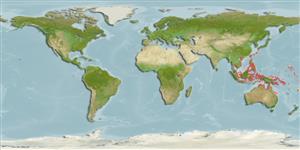>
Blenniiformes (Blennies) >
Blenniidae (Combtooth blennies) > Salariinae
Etymology: Blenniella: Diminutive of blennius, Greek,blenios = mucus (Ref. 45335).
More on author: Bleeker.
Environment: milieu / climate zone / depth range / distribution range
Ecologia
marinhas associadas(os) a recifes; intervalo de profundidade 0 - 3 m (Ref. 90102). Tropical; 30°N - 30°S
Western Pacific: Ryukyu Islands southward to McClure and New Year Islands, Northern Territory, Australia.
Tamanho / Peso / Idade
Maturity: Lm ? range ? - ? cm
Max length : 16.0 cm TL macho/indeterminado; (Ref. 48636)
Espinhos dorsais (total): 12 - 14; Raios dorsais (total): 19-22; Espinhos anais 2; Raios anais : 18 - 22; Vértebras: 37 - 41. Diagnosis: Dorsal fin XII-XIV, 19-22, notched between spinous and segmented-ray portions; anal fin II, 18-22; pectoral rays 13-15 (usually 14); pelvic fin I, 3; caudal fin, procurrent rays 10-14, segmented rays 11-13. Vertebrae 11-12 + 26-29. Orbital cirrus simple filamentous; nasal cirri short and palmate with 2-6 branches; nape without cirri. Lateral line, continuous anterodorsally with simple pores below dorsal spines from 6-7th to 9-10th, disconnected bi-pored series posteroventrally ending below 9th dorsal spine to 1st segmented ray. Mandibular pores 5-7 Lips margin entire. Occipital crest low (up to 2.6 mm) in males, most females only have faint indication of ridge-like crest precursor except greatest specimens which may have a developed ridge up to 0.6 mm (Ref. 559, 9962). Body depth at anal-fin origin 6.8-7.3 in SL. Male body with vertical bars olive brown separated by paler interspaces, and also with dark thin horizontal stripes; also with spots near the tail; preopercular spot dark; dorsal fin spots brown, forming bands. Female with vertical dark H-shaped bars; dorsal fin spotted, caudal fin with 4-5 dark bars (Ref. 48636, 90102). Exhibits geographical color pattern variation (Ref. 9962).
Adults occur in intertidal zones in large rock pools or coastal bays (Ref. 48636). Found near-shore (Ref. 9962); common in tide pools (Ref. 559). They feed on algae scraped from rubble or rock surfaces. Sometimes numerous individuals can be seen clinging to rocks out of the water when the level drops on the low of the swell. When disturbed in rock pools during low tide, they may jump out of the water to get to other rock pools or safer deeper water nearby (Ref. 48636). Oviparous. Eggs are demersal and adhesive (Ref. 205), and are attached to the substrate via a filamentous, adhesive pad or pedestal (Ref. 94114). Larvae are planktonic, often found in shallow, coastal waters (Ref. 94114).
Ciclo de vida ou comportamento de acasalamento
Maturidade | Reprodução | Desova | Ovos | Fecundidade | Larvas
Distinct pairing (Ref. 205).
Springer, V.G. and J.T. Williams, 1994. The Indo-West Pacific blenniid fish genus Istiblennius reappraised: a revision of Istiblennius, Blenniella, and Paralticus, new genus. Smithson. Contrib. Zool. 565:1-193. (Ref. 9962)
Status na Lista Vermelha da UICN (Ref. 130435)
Ameaça para os humanos
Harmless
Uso pelos humanos
Pescarias: sem interesse
Mais informação
ReferênciasAquaculturaPerfil para aquaculturaEstirpesGenéticaElectrophoresesHereditariedadeDoençasProcessamentoNutrientsConversão de massa
ColaboradoresFotosStamps, Coins Misc.SonsCiguateraVelocidadeTipo de nataçãoÁrea branquialOtólitosCérebrosVisão
Ferramentas
Relatórios especiais
Baixar XML
Fontes da internet
Estimates based on models
Preferred temperature (Ref.
123201): 25.4 - 29.3, mean 28.8 °C (based on 1414 cells).
Índice de diversidade filogenética (Ref.
82804): PD
50 = 0.5020 [Uniqueness, from 0.5 = low to 2.0 = high].
Bayesian length-weight: a=0.00741 (0.00335 - 0.01640), b=3.02 (2.83 - 3.21), in cm total length, based on LWR estimates for this (Sub)family-body shape (Ref.
93245).
Nível Trófico (Ref.
69278): 2.0 ±0.0 se; based on diet studies.
Resiliência (Ref.
120179): Elevada, tempo mínimo de duplicação da população menor que 15 meses (Preliminary K or Fecundity.).
Fishing Vulnerability (Ref.
59153): Low vulnerability (10 of 100).
Nutrients (Ref.
124155): Calcium = 122 [59, 218] mg/100g; Iron = 0.748 [0.407, 1.330] mg/100g; Protein = 18 [17, 19] %; Omega3 = 0.065 [0.032, 0.125] g/100g; Selenium = 18.3 [8.5, 42.8] μg/100g; VitaminA = 102 [24, 432] μg/100g; Zinc = 2.37 [1.53, 3.52] mg/100g (wet weight);
